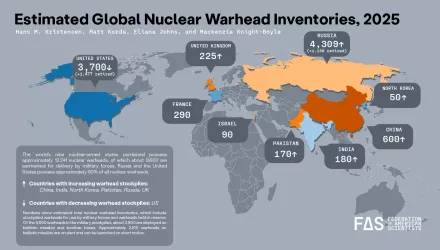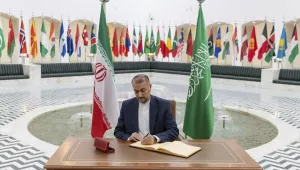While local politics in India mandate an internal focus, recent Indian administrations have understood that achieving their domestic objectives will require the engagement of the international community. In recent years, India's military, diplomatic and economic energies have expanded far beyond Nehru's Non-Aligned position. But what does that mean for India, its region, and the United States?
CURRENT SITUATION
India's foreign policy is driven by five principal factors, through which are interwoven its relationships with two countries: the United States and China.
1. Conventional Security:
- Pakistan is historically perceived to be India's main conventional threat, as evidenced by the military stand-off in late 2001 and early 2002.
- At the same time, India lost a war to China in 1962. China is also India's closest military equal, a fact made most clear when India pronounced that its 1998 nuclear tests were in response to the China risk.
- India's military is rooting out internal militancy prevalent (in the northeast, in the east (among the Naxelite groups), and in Jammu and Kashmir.) Notably, however, there are no known Indian al Qaida or Taliban members (excepting the 2006 Heathrow plot).
- India is also located in a volatile neighborhood, with ongoing wars, insurgencies and unrest taking place in Sri Lanka, Nepal, Pakistan, and Afghanistan, and a coup in Bangladesh.
2. Economic Growth:
- For decades, India maintained what economists termed a "Hindu" rate of GDP growth between 1.5 and 3%. Following the 1991 economic reforms, growth tripled and has stabilized since 2006 at 8-9.5%. However, if India hopes to continue to lift up the 60% of its population in the rural sector and build infrastructure, it must increase its foreign financing significantly.
- Exchange with its neighbors has supported India's growth, from the "Look East" policy of the early 1990's to today's increasing engagement with ASEAN, BIMSTEC, and the new SAFTA agreement. At the same time as it pursues regional agreements, India also engages bilaterally (with free trade agreements with Singapore and a possible bilateral investment treaty with the U.S.) and globally, taking a leadership position in the WTO Doha negotiations.
- India's growth has been bolstered by China, which has achieved annual growth of over 10% since 2000. However, the two countries will compete increasingly, as India engages in China's traditional stronghold of manufacturing, and China focuses on the services market.
3. Energy Security:
- India currently imports 70% of its oil and 50% of its gas; it is projected to import 80% of its energy needs by 2025.
- While India holds that it should be allowed to expand energy consumption and emissions until its per capita levels correspond with those of Western countries, increasingly polls indicate that the Indian public is recognizing the importance of more attention to environmental concerns.
- India is increasingly exploring nuclear power as an alternative energy source (presuming the U.S.-India July 2005 civil nuclear agreement is completed); it is also one of the leading R&D venues for solar and wind power. However, currently only 6% of potential non-conventional energy resources have been tapped.
- In an effort to ensure access to energy resources, India will continue to focus on the Middle East, particularly Iran (including the Iran-Pakistan-India oil pipeline). At the same time, India is expanding its search for energy resources into Africa and Latin America (though India typically loses bids to China).
4. Nuclear Capability and Nonproliferation:
- India's nuclear policy is shaped by its unstable relations with Pakistan and China, as well as the recent escalation of nuclear proliferation in the wider region. Its goal is to build a "credible minimum deterrent" through land-, air-, and sea-based capabilities.
- Since 2002, the India-Pakistan Composite Dialogue has significantly lowered tensions and resulted in several agreements to mitigate the chance of a mistaken nuclear attack.
- If the U.S.-India civil nuclear agreement is completed (see India-Iran Relations briefing memo), India will be able to take a more active role in promoting nonproliferation directly, a goal that has long been touted as vital to India's national interest.
5. Strategic Stature and Leadership:
- India has the second largest population in the world, and one of the youngest. Its economy, by purchasing power parity, is 4th in the world. India's soft power remains strong, and its military, economic and diplomatic reach is increasingly significant. India is a multi-ethnic and multi-religious democracy. While already a leader of the developing world, India now wants status in the developed world.
- Given South Asia's instability, there are ample opportunities for India to focus on helping to alleviate the conflicts in neighboring Nepal, Sri Lanka and Bangladesh. In so doing, India often confronts China's similar desire for regional leadership and seniority (such as China's desire to exclude India in 2005 from the newly formed East Asia Summit (EAS)).
- In addition to focusing on bilateral relationships, India engages in regional and ad hoc groups such as the 2004 Asian Tsunami Core Response Group, and enhancing its status in global groups (such as its bid to become a permanent member of the UN Security Council and interest in the G8).
POLICY IMPLICATIONS
These five broad drivers of India's foreign policy have major implications for its relations with the two principal regional (and global) powers: China and the United States.
China
- Given their mutual desire for stability leading to economic growth, China and India have worked hard in recent years to improve their relationship with senior diplomatic visits — Chinese President Hu Jintao visited in 2006 and Indian Prime Minister Manmohan Singh reciprocated in January 2008 — along with numerous ministerial level visits and, starting in December 2007, joint military exercises.
- At the same time, the two nations are hedging their bets, with China developing a "string of pearls" policy to encircle India by building relationships with its neighbors, from its long-standing strong links to Pakistan, to improving engagement with Burma and Bangladesh. India is countering this by building its own avenues of leverage in the region.
- Increasingly the environment is going to conspire to complicate this relationship, building on inherent areas of conflict in the economic, energy, nuclear, strategic and security realms. These pressures are likely to increase as both India and China pursue leadership roles in Asia.
United States
- Since 2000, India's relations with the United States have undergone a "transformation," reaching a level of primacy today. After advocating for non-alignment (while tilting towards the Soviet Union during the Cold War), India began to move towards a more self-determining policy in the 1990s. In 2000, then-President Clinton led a path-breaking visit to India that transformed Indian views of the U.S. and launched the new relationship. The foundations for this new interaction were put in place by U.S. Ambassador Robert Blackwill from 2001 to 2003.
- America's principal challenges today lie in such areas as terrorism, extremism, proliferation of weapons of mass destruction, economic growth, energy, environment, narcotics, Iraq, Iran, Afghanistan, North Korea and potentially China. These are very similar to the principal foreign policy challenges facing India today. And, in many cases they can only be addressed through long-term engagement and cooperation by the U.S., India, and many of their other allies.
- However, this bilateral relationship is held back by a number of constraints, most notably bureaucratic inertia and lack of trust, and the political considerations that accompany democratic polities.
RECOMMENDATIONS
As India advances its position in the world and lives up to the potential that its character and natural assets imply, it could become a powerful force for transformation in key areas such as energy, nonproliferation, environment, economic development and terrorism. However, if the United States does not engage seriously on an equal basis with India, the vacuum will be filled with other players, and America will have lost an opportunity to build a strong and vital alliance with a growing Asian power.
Given this, the United States should pursue the following principles with India:
- Build a truly strategic relationship with India that transcends the civil nuclear deal. This requires committing time, energy and resources to other significant elements of the relationship.
- Continue to treat India as a principal world player, including supporting India's bid for permanent membership in the United Nations Security Council and the G8.
- Support India's involvement in global energy groups, including the International Energy Agency (IEA) and serious bilateral engagement on post-Kyoto protocols. The United States will need to find ways through R&D and financial incentives to help India build "green."
- Push India to start to carry the burdens of leadership in areas of its direct interest, such as nonproliferation and terrorism.
Download this policy brief as a PDF below.
Dormandy, Xenia. “India's Key Foreign Policy Issues.” April 7, 2008




